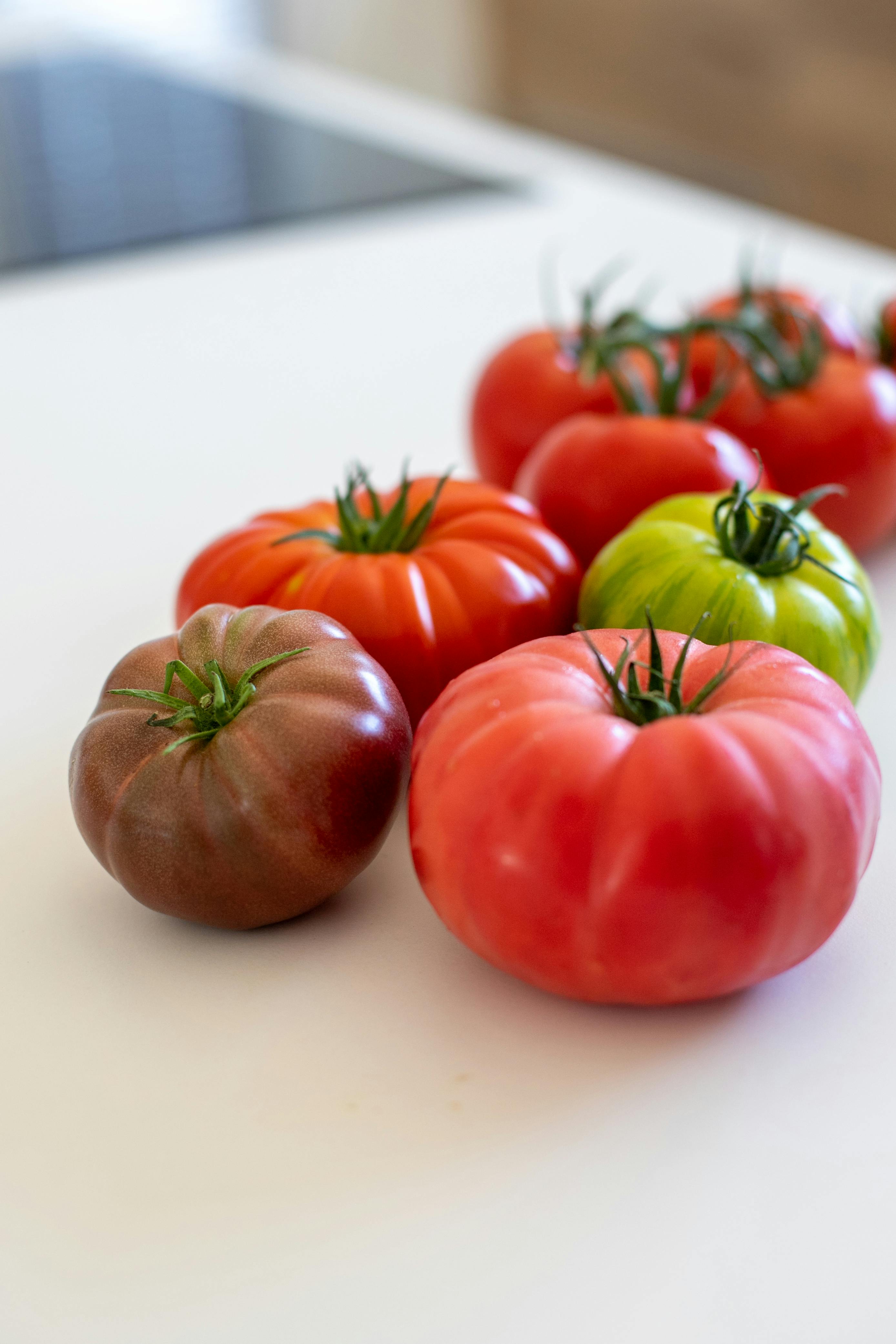
How to Grow ‘Cherokee Purple’ Tomatoes
Have you ever tasted a tomato so rich, flavorful, and juicy that it seems to have come straight from the past? If not, then you’re in for a treat with ‘Cherokee Purple’ tomatoes! These heirloom tomatoes are not just renowned for their unique color and robust flavor but also for the rich history they carry. Growing your own ‘Cherokee Purple’ tomatoes can be a rewarding experience that brings a taste of history to your garden and your plate.
In this detailed guide, we’ll cover everything you need to know about growing ‘Cherokee Purple’ tomatoes, from selecting the right seeds to harvesting these stunning fruits. Whether you’re a seasoned gardener or a novice, this guide will help you successfully grow these beautiful tomatoes in your garden.
What Makes ‘Cherokee Purple’ Tomatoes Special?
Before we jump into the details of growing ‘Cherokee Purple’ tomatoes, let’s take a moment to appreciate what makes them so special. These tomatoes are an heirloom variety, meaning they have been passed down through generations without significant alteration. The story goes that ‘Cherokee Purple’ tomatoes were originally cultivated by the Cherokee people, who shared the seeds with settlers. Today, they are cherished for their rich, smoky flavor and deep, dusky purple-red color.

1. Unique Appearance
The color of ‘Cherokee Purple’ tomatoes sets them apart from other varieties. Their deep reddish-purple skin is often tinged with green shoulders, creating a beautiful contrast. When sliced, the inside reveals a vibrant, dark flesh that is almost wine-colored. This striking appearance makes them a favorite among gardeners and chefs alike.
2. Rich Flavor
Flavor is where ‘Cherokee Purple’ tomatoes truly shine. They offer a complex, sweet, and slightly smoky taste with a perfect balance of acidity. This makes them ideal for fresh eating, in salads, on sandwiches, or even as the star of a tomato tart. Their flavor is often described as old-fashioned, reminiscent of tomatoes grown in a time before mass commercial farming.
3. Heirloom Heritage
As an heirloom tomato, ‘Cherokee Purple’ has been grown and cherished for generations. Unlike hybrid tomatoes, which are bred for uniformity and disease resistance, heirlooms like ‘Cherokee Purple’ are open-pollinated and retain the characteristics that have made them favorites among home gardeners for centuries.
Choosing the Right Location for Your ‘Cherokee Purple’ Tomatoes
The first step in growing successful ‘Cherokee Purple’ tomatoes is choosing the right location. These tomatoes, like most varieties, thrive in full sun and well-drained soil. Here’s what you need to consider when selecting a spot in your garden:
1. Sunlight Requirements
‘Cherokee Purple’ tomatoes need plenty of sunlight to grow and produce fruit. Aim for at least 6-8 hours of direct sunlight per day. More sun generally leads to better fruit production, so choose a spot that receives full sun throughout the day.
2. Soil Preparation
Tomatoes prefer slightly acidic soil with a pH between 6.0 and 6.8. Before planting, it’s a good idea to test your soil’s pH and amend it if necessary. You can lower the pH by adding sulfur or raise it by adding lime. Additionally, tomatoes thrive in nutrient-rich soil, so work in plenty of organic matter, such as compost or well-rotted manure, to improve soil fertility and structure.
3. Space Considerations
‘Cherokee Purple’ tomatoes are indeterminate, meaning they continue to grow and produce fruit throughout the growing season. As a result, they can become quite large and sprawling. Ensure you have enough space to accommodate their growth, and plan for adequate spacing between plants. A general rule of thumb is to space plants about 18-24 inches apart to allow for proper air circulation, which helps prevent disease.

Planting ‘Cherokee Purple’ Tomatoes
Once you’ve selected the perfect spot, it’s time to plant your ‘Cherokee Purple’ tomatoes. Whether you’re starting from seeds or transplants, proper planting techniques are crucial for a healthy and productive crop.
1. Starting from Seeds
If you’re starting from seeds, begin indoors about 6-8 weeks before the last expected frost date in your area. Plant seeds in seed-starting trays filled with a quality seed-starting mix. Sow the seeds about 1/4 inch deep, and keep the soil consistently moist.
To promote strong, healthy seedlings, provide them with plenty of light. A sunny windowsill or grow lights work well. Once the seedlings have their first set of true leaves, you can begin to harden them off by gradually exposing them to outdoor conditions. This process typically takes about a week.
2. Transplanting Seedlings
When the danger of frost has passed and the soil has warmed up, it’s time to transplant your seedlings into the garden. Choose a cloudy day or transplant in the early morning or late afternoon to reduce transplant shock.
Dig a hole deep enough to bury the stem up to the first set of true leaves. This encourages strong root development. If your seedlings are leggy, you can even plant them on their side, bending the stem gently so that the top few leaves are above the soil surface.
Water the plants thoroughly after transplanting to help settle the soil and reduce shock. Mulching around the base of the plants can help retain moisture and suppress weeds.
3. Direct Sowing
If you live in a warm climate with a long growing season, you can also direct sow ‘Cherokee Purple’ tomatoes in the garden after the last frost. Plant seeds about 1/4 inch deep and keep the soil consistently moist until germination occurs.
Caring for ‘Cherokee Purple’ Tomatoes
Once your ‘Cherokee Purple’ tomatoes are planted, it’s important to provide them with the care they need to thrive. Proper watering, feeding, and support are key to growing healthy plants that produce an abundance of fruit.
1. Watering
Tomatoes need consistent moisture to prevent issues like blossom-end rot and cracking. Water deeply and regularly, aiming to keep the soil evenly moist. Avoid overhead watering, as wet foliage can lead to fungal diseases. Instead, water at the base of the plants using a soaker hose or drip irrigation system.
During hot, dry weather, you may need to water more frequently. A layer of mulch around the base of the plants can help conserve moisture and keep the soil temperature stable.
2. Feeding
Tomatoes are heavy feeders, so regular fertilization is important for healthy growth and fruit production. Begin feeding your plants about two weeks after transplanting with a balanced fertilizer, such as a 10-10-10 formula. Once the plants start setting fruit, switch to a fertilizer higher in phosphorus and potassium, such as a 5-10-10, to encourage fruit development.
Organic options like compost tea, fish emulsion, and bone meal are also excellent choices for feeding your tomatoes. Apply fertilizer according to the manufacturer’s instructions, and be careful not to over-fertilize, as this can lead to excessive foliage growth at the expense of fruit production.
3. Staking and Support
As indeterminate tomatoes, ‘Cherokee Purple’ plants will continue to grow and produce fruit throughout the season, often reaching heights of 6 feet or more. To prevent the plants from sprawling on the ground and to keep the fruit clean and free from pests, it’s important to provide support.
Staking, caging, and trellising are all effective methods for supporting tomato plants. Staking involves driving a sturdy stake into the ground next to each plant and tying the main stem to the stake as it grows. Tomato cages are another popular option, providing support for the plant as it grows and allowing the branches to spread naturally.
Trellising is a bit more involved but can be very effective for larger gardens. It involves training the plants to grow along a horizontal structure, such as a fence or wire grid. This method provides excellent air circulation and makes harvesting easier.
4. Pruning
Pruning is an important part of caring for indeterminate tomatoes like ‘Cherokee Purple’. By removing the suckers (the small shoots that grow between the main stem and the branches), you can direct the plant’s energy into producing larger, healthier fruit. However, some gardeners prefer to let their plants grow naturally, believing that more foliage helps protect the fruit from sunscald.
If you choose to prune, start early in the season and be consistent. Remove the suckers when they are small, using clean, sharp scissors or pruners. Be careful not to remove too many leaves, as this can stress the plant and reduce its ability to photosynthesize.

Managing Pests and Diseases
Like all tomato plants, ‘Cherokee Purple’ tomatoes are susceptible to a variety of pests and diseases. However, with proper care and attention, you can minimize the impact of these issues and enjoy a healthy, productive crop.
1. Common Pests
- Aphids: These tiny, sap-sucking insects can weaken tomato plants and spread disease. To control aphids, spray the plants with a strong stream of water to knock them off, or use insecticidal soap if the infestation is severe.
- Tomato Hornworms: These large, green caterpillars can quickly defoliate a tomato plant. Hand-pick them off the plants, or use an organic insecticide like Bacillus thuringiensis (Bt) if the infestation is severe.
- Whiteflies: These small, white insects can cause yellowing and weakening of the plants. Sticky traps and insecticidal soap are effective for controlling whiteflies.
2. Common Diseases
- Blight: Both early and late blight can affect ‘Cherokee Purple’ tomatoes, causing yellowing and browning of the leaves. To prevent blight, avoid overhead watering and provide good air circulation around the plants. If blight appears, remove and destroy affected foliage, and consider using a fungicide if the disease is severe.
- Fusarium and Verticillium Wilt: These soil-borne diseases cause the leaves to wilt and turn yellow. Unfortunately, there is no cure for these diseases, so it’s important to plant disease-resistant varieties and rotate crops to prevent the buildup of pathogens in the soil.
- Blossom-End Rot: This common issue is caused by a calcium deficiency and results in dark, sunken spots on the bottom of the fruit. To prevent blossom-end rot, ensure consistent watering and avoid excessive nitrogen fertilization.
3. Preventative Measures
- Crop Rotation: Rotate your tomato crops each year to reduce the risk of soil-borne diseases.
- Sanitation: Remove and destroy any diseased plants or plant debris at the end of the season to prevent overwintering of pests and diseases.
- Companion Planting: Planting herbs like basil and marigolds near your tomatoes can help repel pests and improve plant health.
Harvesting and Enjoying ‘Cherokee Purple’ Tomatoes
One of the most rewarding aspects of growing ‘Cherokee Purple’ tomatoes is harvesting and enjoying the fruits of your labor. These tomatoes are typically ready to harvest 80-90 days after transplanting, depending on the growing conditions.
1. When to Harvest
‘Cherokee Purple’ tomatoes are ready to harvest when they have reached their full size and their color has deepened to a rich, dusky purple-red. The fruit should feel slightly soft to the touch but still firm. If you’re unsure, pick a test tomato and cut it open—if the interior is a deep, rich color and the flavor is sweet and complex, the tomatoes are ready.
2. How to Harvest
To harvest, use a sharp knife or garden shears to cut the fruit from the plant, leaving a short stem attached. Be careful not to pull or twist the tomatoes, as this can damage the plant.
3. Storing and Using
‘Cherokee Purple’ tomatoes are best enjoyed fresh, but they can be stored at room temperature for a few days. Avoid refrigerating them, as cold temperatures can diminish their flavor and texture.
These tomatoes are incredibly versatile in the kitchen. Slice them for sandwiches, chop them for salads, or use them in sauces, salsas, and more. Their rich flavor also makes them an excellent choice for canning or preserving.
Growing ‘Cherokee Purple’ tomatoes is a rewarding experience that combines the joy of gardening with the pleasure of tasting a truly unique and flavorful fruit. With their rich history, striking appearance, and exceptional flavor, these heirloom tomatoes are a must-grow for any garden enthusiast.
By following the steps outlined in this guide, you’ll be well on your way to growing healthy, productive ‘Cherokee Purple’ tomato plants that will provide you with delicious, homegrown tomatoes all season long.




